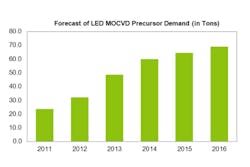LEDs are enjoying widespread adoption across industrial, commercial and residential settings, causing component makers and distributors to step up their game when it comes to building and introducing the newest solutions for lighting manufacturers. Distributors such as Digi-Key Corp. are keeping up by pairing new products with design services to help those manufacturers speed their time-to-market.
“We view Digi-Key’s role as helping [customers] get to market faster,” explains Robbie Paul, Digi-Key’s director of lighting sales. “The traditional development cycle in lighting is 12 to 18 months, but the LED cycle is much faster. That’s something new and different for lighting OEMs. They’re not used to developing and evolving their products as quickly as they do now.”
It’s especially new and different for smaller lighting OEMs that have little experience in developing LED solutions, Paul explains. But he says distributors are seeing more interest from that part of the market as LED adoption grows.
“The question is how do more of the 2000 small and mid-size lighting OEMs participate in this market?” Paul asks. “This is new to them, so it’s a key place for us to help.”
Distributors have long been on the front lines of new product introductions, and most have been building their service offerings recently, especially online. Reference design libraries, micro-sites and other lighting-focused online resources are a few examples. But traditional component manufacturers are finding an even more pressing need to broaden their offerings in the LED department. Paul points to increasing customer demand for integrated solutions such as pre-configured boards designed for LED applications.
“Many small to mid-sized [lighting] companies don’t have adequate resources to tackle the electronic challenges [involved in LED design],” explains Paul, pointing to integrated devices that an OEM can take and connect into a system or design. “We’re thinking and looking more towards the complete solutions base, all in the effort to get the customers to market faster.”
Set for growth
Digi-Key pegs the North American LED market for 15% to 20% growth this year, led by the West Coast where government regulations are driving a switch to more efficient lighting and energy solutions, Paul explains.
A recent report from industry analyst IHS also points to LED market growth, noting a significant increase ahead in raw materials used to make LEDs. For instance, global demand for precursor, a material used in manufacturing LEDs, is set to more than double from 2012 to 2016 according to IHS’s report titled “Precursor for LED MOCVD-Market and Industry Analysis,” released in August. The market for precursor used in the metal-organic chemical vapor deposition (MOCVD) manufacturing process for making LEDs will rise to 69 tons in 2016, up 114% from 32 tons in 2012, the report says (see the figure).
“The boom in the precursor market reflects the rising operating rate of MOCVD as the LED lighting market grows,” explains Richard Son, senior LED analyst at IHS.
Precursor is a core material that ensures the optimal light efficiency for each LED epi layer, according to IHS. It is used in the MOCVD process, the key process in manufacturing LED chips. Major precursors include trimethylgallium (TMGa), trimethylindium (TMIn), trimethyl aluminum (TMA), triethylgallium (TEGa), and C2Mg2. Among these, TMGa is the most widely used and commands about 94% of total demand. Global shipments of MOCVD equipment are also on the rise, with shipments expected to climb by 17% in 2013, IHS says.
Paul points to related growth across all end markets, with commercial and industrial segments leading the way. On the commercial side of the business in particular, he sees rising demand for full-fledged LED fixtures, reflected in growing sales among lighting manufacturers designing those types of solutions. On the residential side, demand is still concentrated in replacement lamps, a trend he expects to continue for the next few years. But Paul emphasizes that sales of LEDs and associated components are enjoying rapid sales growth in general.
“So that’s a positive trend for us,” he says.
Paul also points to makers of lighting controls as a big growth area.
“Companies that make dimmers and other controls that go along with LED lighting are experiencing even greater sales growth than the LED manufacturers,” he says, adding that controls and sensors generally are becoming a more important part of the solid-state lighting market.









